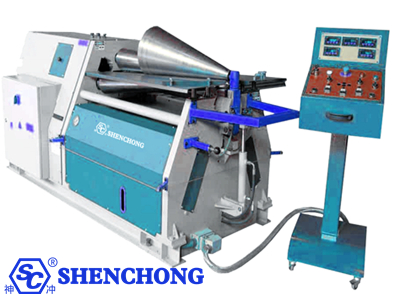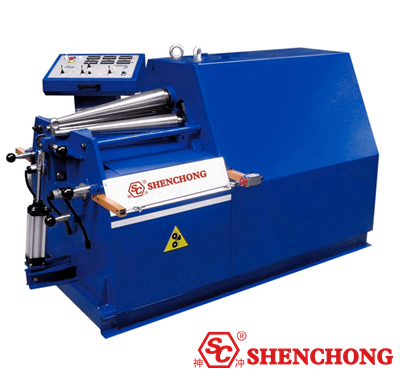
The cone rolling machine is a mechanical device specially used to roll metal sheets into a conical cylinder or cone. The following is the operation guide of the cone rolling machine, including preparation, operation steps and precautions, which is applicable to the cone rolling function of common three-roller or four-roller plate rolling machines.

The cone rolling machine is a device used to roll round or conical workpieces and is widely used in the metal processing industry. Its main structure includes: upper roller, lower roller, side roller (or pressure roller), drive system and hydraulic system, etc.
Check whether the power supply, hydraulic system, and transmission system are normal, and ensure that there is no abnormal sound or leakage.
Check whether each roller is clean and free of debris.
Ensure that the emergency stop button and safety protection device are working properly.
Select a plate suitable for rolling and check whether there are cracks, defects or unevenness.
Mark the bending start line and symmetry center line according to the requirements of the workpiece.
Adjust the position of the upper, lower, and side rollers according to the thickness and taper of the plate.
Set the appropriate pressure and feed speed.
Turn on the power and enter the cone rolling machine operation interface or control panel.
Select the rolling mode (conical or circular).
Set the rolling speed and clamping force.
Place the plate correctly between the lower roller and the side roller to keep it symmetrical.
Adjust the rollers appropriately to ensure that the plate enters stably.
Start the main roller movement gradually to start bending the sheet.
Adjust the side roller pressure to gradually form an arc or taper on the workpiece.
Make multiple adjustments to gradually approach the target shape.
Observe whether the workpiece meets expectations. If there is any deviation, adjust it in time.
Stop rolling when the workpiece reaches the expected shape and size.
Gradually release the pressure to prevent the workpiece from rebounding and deforming.
Use auxiliary tools to remove the workpiece to avoid damage to the equipment or the workpiece.
When using the cone rolling machine, the operating procedures must be strictly followed to ensure the normal operation of the equipment and the safety of personnel. The following are key precautions:

Wear protective equipment: Operators must wear protective gloves, safety shoes and goggles to prevent metal debris.
No hand contact with the roller: During the rolling process, it is strictly forbidden to directly touch the roller and the plate to prevent pinching.
Emergency stop button inspection: Before each operation, confirm that the emergency stop button can work normally.
No overload operation: The equipment should be operated within the rated capacity to avoid damage due to overload.
Adjust reasonable pressure: The side roller pressure should be gradually adjusted during rolling to avoid excessive pressure at one time, which may cause material rupture or equipment damage.
Proper plate placement: Ensure that the plate is correctly aligned to prevent deviation or uneven deformation.
Pre-start inspection: Ensure that there are no abnormalities in the power supply, hydraulic system, rollers, and fasteners.
Adjust gradually: When rolling conical parts, the side roller angle should be adjusted reasonably to gradually reach the target shape and avoid excessive adjustment at one time.
Stable feeding: During the rolling process, the plate should be fed evenly to avoid sudden acceleration or emergency stop.
Clean the equipment daily: remove impurities and dust on the rollers to avoid affecting the rolling accuracy.
Check lubrication regularly: ensure that the rollers, bearings, and transmission parts are well lubricated to reduce wear.
Check the hydraulic system: Check the hydraulic oil level regularly to prevent leakage caused by aging of the oil seal.
Abnormal conditions | Possible reasons | Solution |
Abnormal vibration of equipment | Damaged bearings or loose bolts | Check the bearings and tighten the bolts |
Plate deviation | Improper adjustment of side rollers | Re-adjust the side roller position |
No pressure in hydraulic system | Oil pump failure or pipeline blockage | Check the oil pump and clean the pipeline |
Motor overheating | Overload operation or poor cooling | Stop the machine to cool and check the load |
In order to ensure the long-term stable operation of the cone plate rolling machine, improve the processing accuracy and extend the service life of the equipment, regular maintenance and care are required. The following are detailed maintenance points:
Wipe the roller surface to remove dust, iron filings and impurities to prevent affecting the plate rolling accuracy.
Regularly check and clean the hydraulic system pipeline to prevent blockage.
Wipe the control panel to prevent dust from entering the electrical system.
Check whether all bolts and nuts are loose, especially the transmission part and hydraulic pipeline connection. If loose, tighten them in time.
Ensure that all transmission parts (bearings, gears, screws, etc.) are well lubricated to avoid dry grinding damage.
Check and add appropriate amount of lubricating oil to reduce friction and improve roller operation efficiency.
Add appropriate amount of lubricating oil or grease according to the requirements of the equipment manual.
Key lubrication parts: main bearings, side roller bearings, worm gears, chains, etc.
Check whether the hydraulic oil level is normal, and whether the hydraulic oil is clean and free of impurities.
Observe whether the hydraulic pipeline is leaking, aging or loose.
Ensure that the power connection is stable, check whether the motor is running normally, and avoid short circuit or poor contact.
Ensure that the emergency stop button is available normally to prevent the equipment from being unable to stop in case of emergencies.
Check whether the hydraulic oil level is sufficient. If it is insufficient, it should be replenished in time.
Observe the color of the oil. If it is found to be deteriorated or impurities, the hydraulic oil should be replaced in time.
Check whether the hydraulic pipeline is leaking, and repair it immediately if it is found.
Check whether the rollers are worn or have surface dents to avoid affecting the rolling quality.
Observe whether the rollers have scratches, cracks, deformation or abnormal wear. If there are any problems, repair or replace them in time.
Test whether the rollers run smoothly, whether there are abnormal noises or shaking, and adjust or replace them in time if problems are found.
Ensure that the roller rotates smoothly to avoid eccentricity or shaking.
According to the thickness of the rolled material, adjust the gap between the upper and lower rollers and the side rollers to ensure uniform pressure.
Ensure that the equipment limit switch works normally to prevent overload or damage to the equipment.
Check whether the protective device is intact to avoid injuries caused by misoperation.
Check whether the motor, circuit, and electrical components have abnormal heating, wear, or poor contact.
Check whether the motor is overheated or makes abnormal noises, and confirm that the operation is in good condition.
Clean the dust on the motor radiator to ensure normal heat dissipation.
Check whether the chain, gears, worm gears, etc. are worn or loose, and adjust the tension appropriately.
Ensure that the motor and reducer run without abnormal noise or heating.
Use a ruler or micrometer to detect the roundness of the roller. If it is severely worn, it needs to be replaced or repaired.
Ensure the parallelism of the roller to prevent deviation during the rolling process.
Check whether the hydraulic cylinder and valve are leaking oil, and check whether the seals are aging.
If leakage or aging is found, the seals should be replaced in time to avoid affecting the pressure stability of the hydraulic system.
Check the quality of the hydraulic oil. If the oil is found to be deteriorating (darkening, impurities or bubbles), replace it with new oil.
Clean the hydraulic filter to prevent impurities from clogging the pipeline.
Focus on checking whether the emergency stop button, limit device, and overload protection device are sensitive and effective.
Replace severely worn bearings, seals, oil seals, chains and other key components.
Thoroughly replace the hydraulic oil and clean the sediment in the oil tank and pipelines.
Check whether the hydraulic cylinder and valve are working properly.
Use professional measuring tools to check the parallelism of the rollers and adjust them to the standard range.
Re-debug the equipment control system to ensure normal operating sensitivity.
Perform an overall inspection of the equipment to ensure that all components are operating normally to avoid long-term error accumulation.
Perform a comprehensive inspection of the electric control cabinet and lines to prevent aging, looseness or short circuit of the lines.
Test whether the various control functions of the equipment are normal. If there are any abnormalities, repair them in time.
Fault phenomenon | Possible reasons | Solution |
The equipment cannot start | The power is not connected and the circuit is faulty. | Check the power supply, check the circuit connection |
The roller does not rotate | Motor failure, loose chain, power supply problem | Check the motor, tighten the chain, check the power connection |
Uneven rolling | Uneven sheet thickness or improper pressure setting | Adjust the pressure, check the plate |
Abnormal vibration of the equipment | Worn bearings or loose transmission components | Check and replace the worn parts |
Hydraulic system leaks | Seals are aging or pipelines are loose | Replace the seals, tighten the pipeline |
Abnormal pressure of the hydraulic system | The oil pump is damaged, the hydraulic oil is insufficient or the pipeline is blocked | Replace the oil pump, add hydraulic oil, clean the pipeline |
Automatic shutdown of the equipment | Overload protection or electrical fault | Check the load condition, check the electrical system |
Motor overheats or makes abnormal noise | Long-term overload operation | Stop the equipment to cool down, check the load condition |